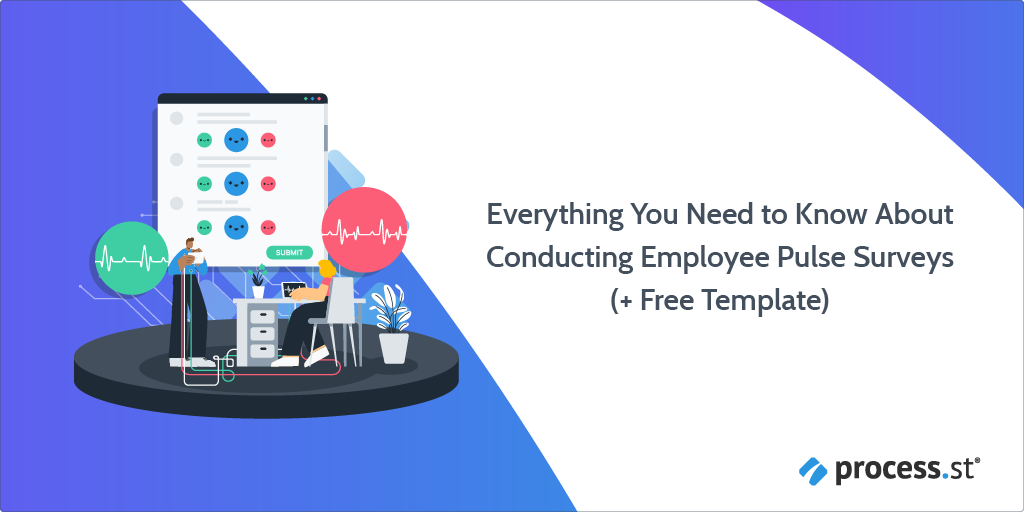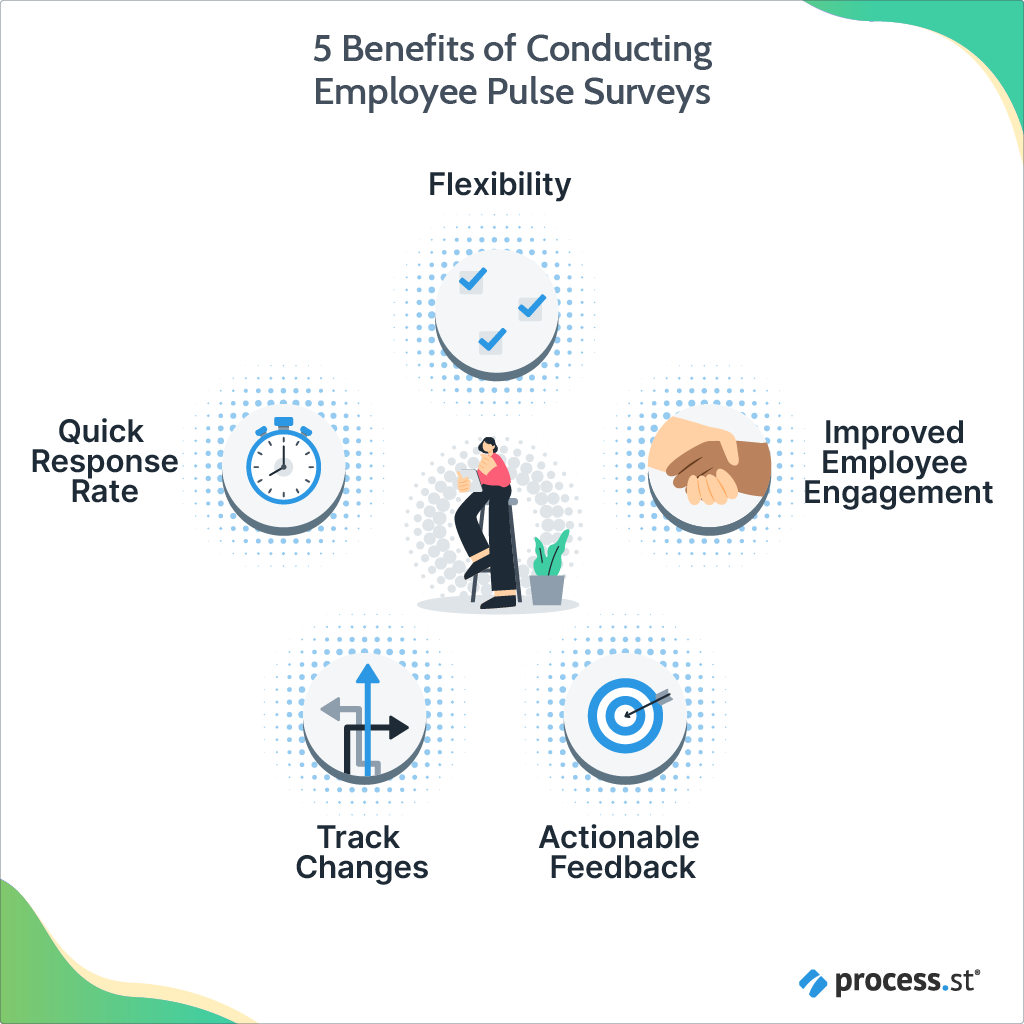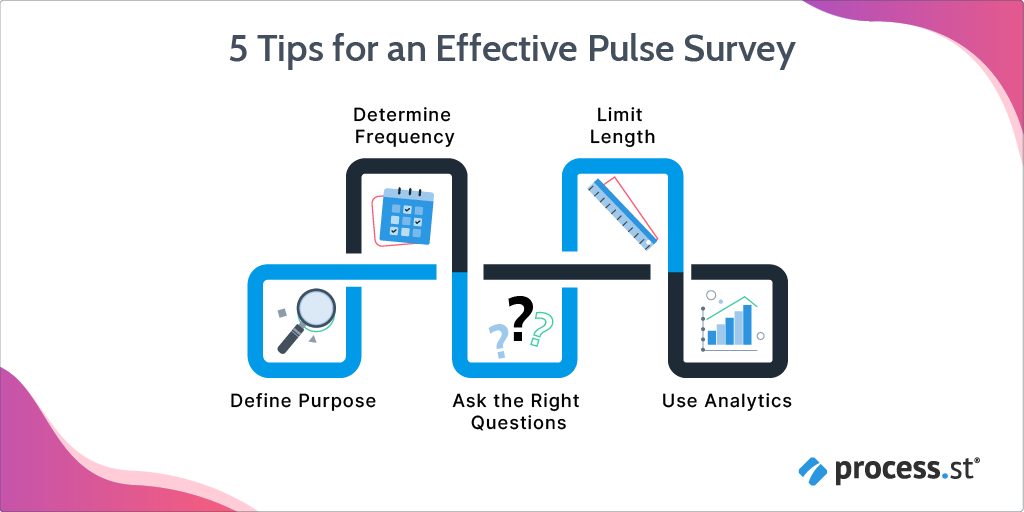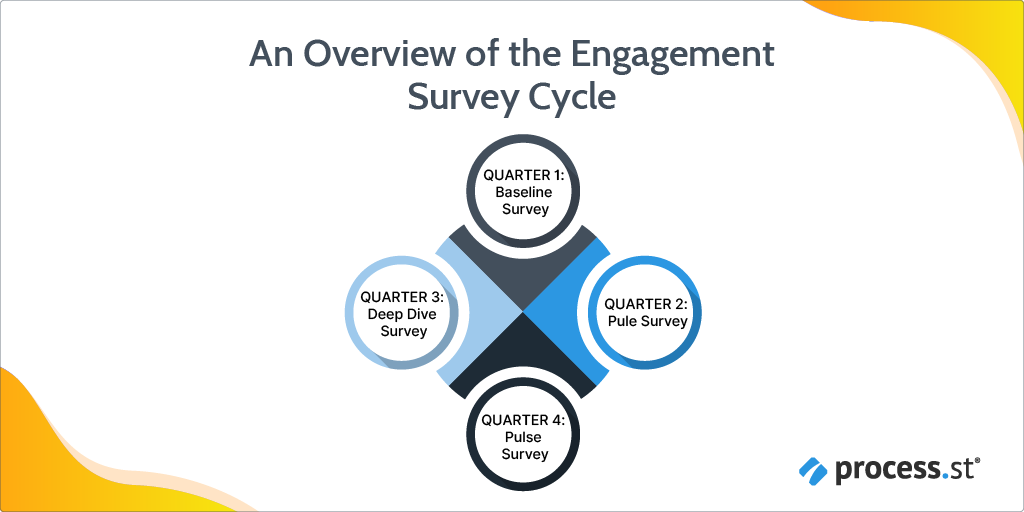
While 52% of senior managers feel the annual engagement survey is an accurate assessment, 48% of employees do not. Factor in that 1/4 of managers think the surveys are pointless and you have a problem.
Annual surveys encompass such a long period of time that it becomes difficult to accurately measure which initiatives have been effective and which are not.
In addition, it limits the ability to make changes to engagement and motivation policies as they need to happen and before it’s too late to correct any potential damage.
An employee pulse survey is useful as a tool for monitoring engagement, but it can also be applied to other situations. A pulse survey might be used to evaluate new procedures, strategies, and business practices to measure their effectiveness.
Paired with annual surveys, the pulse survey is a powerful tool that can keep your goals targeted and productive.
This post for Process Street will cover everything you need to know about employee pulse surveys – and provide a template you can start using immediately with your free Process Street account.
- Employee Pulse Survey template
- What’s the difference between a pulse survey & an engagement survey?
- Pulse survey best practices
- Optimize employee engagement with this free pulse survey template
Let’s dive in!
Employee Pulse Survey template
If you just can’t wait to try it out, grab the free Employee Pulse Survey template here:
What’s the difference between a pulse survey & an engagement survey?
A pulse survey is given more frequently, asks more specific questions, and shouldn’t take much time to complete.
Pulse surveys and engagement surveys cover overlapping areas and can be used for the same purpose. However, a pulse survey is designed to measure employees’ attitudes and reactions to recent changes. The purpose of an engagement survey is to measure employee sentiment about the company as a whole.
Engagement surveys are generally longer, more in-depth, and occur less frequently.
Benefits of using a pulse survey for employee engagement

While the annual employee engagement survey will give you a broader overview of how your employees feel about their jobs and the company, a pulse survey will provide an immediate assessment you can quickly act on.
It’s most effectively used shortly after a new change has been announced or implemented to determine how your employees are reacting to that change. What effect has it had on their workload or work environment? Do they still have adequate resources to fulfill their role? Do they feel the change has been made with their needs taken into consideration?
All of these things can affect the level of engagement your employees feel and knowing about them sooner rather than later can help you address any potential loss in morale and job satisfaction.
The primary benefits of conducting employee pulse surveys include:
- Quick response rate
- Flexibility
- Actionable feedback
- Ability to track changes
- Improved employee engagement
Because the pulse survey doesn’t take much time to fill out, employees are more likely to respond and provide their input on changes within the organization. This quickness also enables you to be more agile in your responses.
When employee feedback has a visible impact on company policies, processes, and procedures, it provides employees with a greater sense of ownership, autonomy, and value.
All of these things contribute to your employees having more trust, loyalty, and commitment to your company.
Pulse survey best practices to improve employee engagement
Using pulse surveys alone won’t increase your employee engagement. In order to do that, you need to be prepared for a number of potential outcomes once the pulse survey has been completed.
You might receive negative feedback from your employees. While this could be upsetting, it’s important to take the time to evaluate why your employees feel this way. Is there something you can do to make them feel more positive about recent changes? Have they been given the proper training and resources to adjust?
Instead of focusing solely on what is said, carefully consider why it’s said.
You may not get the number of responses that you expect. While employees are more inclined to respond to a pulse survey that they can quickly fill out straight from their inbox, sending pulse surveys out too frequently could cause what’s known as “survey fatigue.”
Essentially, this means that your employees lose interest in responding to the surveys. They might feel that their responses don’t matter, or it could become just one more task for them to do in a day with too many tasks already.
Let’s look at some ways you can optimize your pulse survey to get the most out of your efforts.
How to structure your pulse survey
A pulse survey needs to be concise, specific, and targeted. To accomplish this, you need to do five important things:
- Define the purpose: What do you hope to gain from this survey? What information is your main priority?
- Determine the frequency: How often will you give the survey? To get an accurate assessment, the survey will need to be completed more than once, but you don’t want to give it too often, either.
- Ask the right questions: Using your purpose as a guide, only ask questions that directly feed into that purpose. Asking unrelated questions or increasing the length of the survey will limit the responses you get and provide an unreliable overview.
- Limit the length: If the survey is too long, your employees won’t complete it. They might intend to, but ultimately they do have other responsibilities that take priority. A shorter survey also keeps the questions specific and focused on the purpose, whereas a long survey could cover too many areas.
- Use analytics: Pulse surveys are designed to act as a measurement of employee sentiment but you need to know what data you intend to use. How do you plan to rate employee satisfaction and engagement? What factors could be used as indicators?

An effective timeline for your engagement surveys
How often you choose to run your pulse survey will depend on your company’s needs. However, it’s strongly recommended that you don’t run them more often than once a month. Even on a monthly basis, employees can become disengaged due to the frequency and stop responding.
To get the most out of your pulse survey, you need to know your employees and have a clear view of what you want to gain from the survey.

For a majority of instances, the above cycle will provide enough relevant information at frequent enough intervals that you can both act on the feedback you receive and keep your employees involved in the process.
In the first quarter, you’ll conduct the standard employee engagement survey. This survey provides your baseline that you’ll compare future surveys to. This survey should follow the standard perimeters and provide insight into how your employees feel about the company and their roles within it as a whole.
You’ll conduct the first pulse survey in the second quarter. By comparing the results of this survey to the prior engagement survey, you can get an idea of whether or not employee satisfaction has changed in the intervening period, and what could have caused that change.
This comparison is especially important if you’ve added new initiatives, policies, or procedures since the initial survey.
For the third quarter, you should prepare a “deep dive” survey. This will be similar to the initial engagement survey in terms of length and breadth, but should also contain a focus on issues raised in the pulse survey.
The purpose of conducting a “deep dive” into your employees’ sentiments is to provide further detail and context for things affecting their engagement or disengagement.
Finally, for quarter four, you conduct another pulse survey. This may or may not be identical to the previous pulse survey. The questions you ask will be determined by your needs at the time. If your focus has shifted since quarter two, then the questions in this pulse survey need to reflect that.
Once the first quarter comes around again, you can conduct the original employee engagement survey. By using this cycle, you’ll be able to keep track of what impact company changes are having on your employees.
Optimize employee engagement with this free pulse survey template
Knowing which questions to ask to get the answers you’re looking for can be a challenge. The way a question is phrased or presented can drastically change how an individual might respond to it.
For that reason, it’s a good idea to use a standardized template that you can easily edit and run as needed.
The template below offers a good framework for a general employee pulse survey. It asks simple, to-the-point questions that cover the eight factors of employee engagement and also provides space for your employees to provide their own comments.
As mentioned above, the eight sections of the survey match the eight factors of employee engagement:
- Leadership
- Communication
- Culture
- Rewards and recognition
- Professional and personal progression
- Accountability and performance
- Vision and values
- Corporate social responsibility
Each section includes five questions that can be answered using a simple Likert rating scale, followed by a long text field for anything else the employee wishes to add.
Using Process Street Automations, you can export the results of each completed survey into a spreadsheet that ensures your employees’ anonymity. By pairing workflows with your other work apps via Automations, you can unlock a variety of use cases and solutions to keep your employees happy and engaged.
Editing the workflow to add features like conditional logic, rich media widgets, and variables will add an extra layer of interactivity to your pulse survey. Check out the video below for a quick overview of some of Process Street’s most popular features:
Do you have experience with pulse surveys in your company? Let us know about it in the comments!







 Workflows
Workflows Projects
Projects Data Sets
Data Sets Forms
Forms Pages
Pages Automations
Automations Analytics
Analytics Apps
Apps Integrations
Integrations
 Property management
Property management
 Human resources
Human resources
 Customer management
Customer management
 Information technology
Information technology



Leks Drakos
Leks Drakos, Ph.D. is a rogue academic with a PhD from the University of Kent (Paris and Canterbury). Research interests include HR, DEIA, contemporary culture, post-apocalyptica, and monster studies. Twitter: @leksikality [he/him]